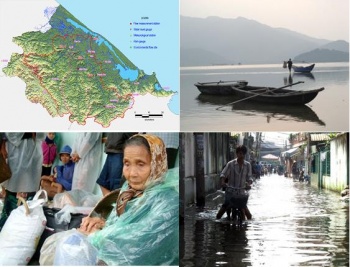Vietnam NCAP Project
Climate Change Impacts in Huong River Basin and Adaptation in its Coastal District Phu Vang, Thua Thien Hue province

Introduction
Located in southeast Asia, with a tropical monsoon climate and a coastline of more than 3,260km, Vietnam is one of the most disaster-prone countries in the world. Most of the disasters that occur in the country are related to weather and climate, and consequently climate change and climate variability are likely to pose increasing threats to Vietnam and its inhabitants in the near and long-term future (Nguyen Trong Hieu, 2006; ADB, 1994)
Climate change is not only an ‘environmental’ issue; it already poses a wider threat to the sustainable development of Vietnam, having impacts on all sectors and regions of the country. In fact, the potential impacts of climate change on Vietnam are considered to be a very serious challenge to national efforts towards hunger eradication, poverty reduction and sustainable development. The sectors most vulnerable to climate change have been identified as: natural resources (water, land, and biodiversity); agriculture and aquaculture; energy; transport; and public health (MONRE, 2003).
According to a recent assessment by the World Bank 2007 Vietnam is among the five most vulnerable countries to the impacts of climate change and consequent sea level rise. The strongest impacts are likely to be experienced in the low land delta (the Mekong River delta in the south and Red River delta in the north) and coastal areas (Dasgupta et al., 2007; World Bank, 2007). With a projected sea level rise of 1m by 2100, about 10% of the Vietnamese population would be directly affected and GDP would decrease by the same percentage. If the projected changes come to pass, approximately 40,000km2 of the coastal areas and deltas would be inundated every year, including the complete swamping of about 80% of the Mekong River delta’s area (HMS, 1996).
Even though more and more people are starting to become aware of the potential threats posed by climate change, climate change is also a relatively new and complicated challenge, which may cause short-term impacts and enormous potential risks and uncertainties in the future. Although the people of Vietnam have thousand year old traditions of confronting and overcoming a variety of natural disasters, identifying adaptation options to climate change at different scales may require new approaches (Le Nguyen Tuong et al., 2006).
It is in this context that the Institute of Hydrology, Meteorology and Environment (IMHEN) and the Department of Natural Resources and Environment (DONRE) in Hue developed and implemented the project ‘Climate Change Impacts in the Huong River Basin and Adaptation in its Coastal District Phu Vang’. The project was part of the second phase of the Netherlands Climate Assistance Program and took place from 2005 to 2008.
Objectives
The main objective of the project was to strengthen the capacity and preparedness of the different sectors, organizations and people in Vietnam to adapt and respond to the changing climate. A particular focus of the project has been on water resources and hydrology at the basin level, as well as a deeper investigation into adaptation issues at the local level. Thua Thien Hue Province, the Huong River Basin and Phu Vang district in Vietnam were chosen for this pilot study. Through this, the project also tried to contribute towards the implementation of Vietnam’s national strategy for poverty elimination and sustainable development. The results and findings of the project may be further analyzed to develop a participatory climate change adaptation and integrated water resource management model, which can be used in other basins and areas nationwide.
Specific objectives of the project were:
- To combine water flow modeling for an entire river basin with participatory management tools for a coastal district or village.
- To study existing and future climate change impacts on water resources in the river basin and understand how poor people’s livelihoods depend strongly on climate and water resource changes.
- To improve awareness, a proactive attitude and preparedness regarding climate change and its impacts among all related stakeholders, especially the local authority and policy makers and the most vulnerable communities.
- To understand local customs and indigenous knowledge regarding weather, climate and disasters and assess and improve existing adaptation measures with stakeholder’s participation.
- To prepare and develop, with stakeholder participation, the optimal feasible adaptation plan and policy at district level with a view to replicate them at provincial and national levels.
Next. . .
On to:
Methodology of Vietnam NCAP Project
Key findings from Vietnam NCAP Project
Lessons learned from Vietnam NCAP Project
Back to: Netherlands Climate Assistance Programme (NCAP)
(0) Comments
There is no content